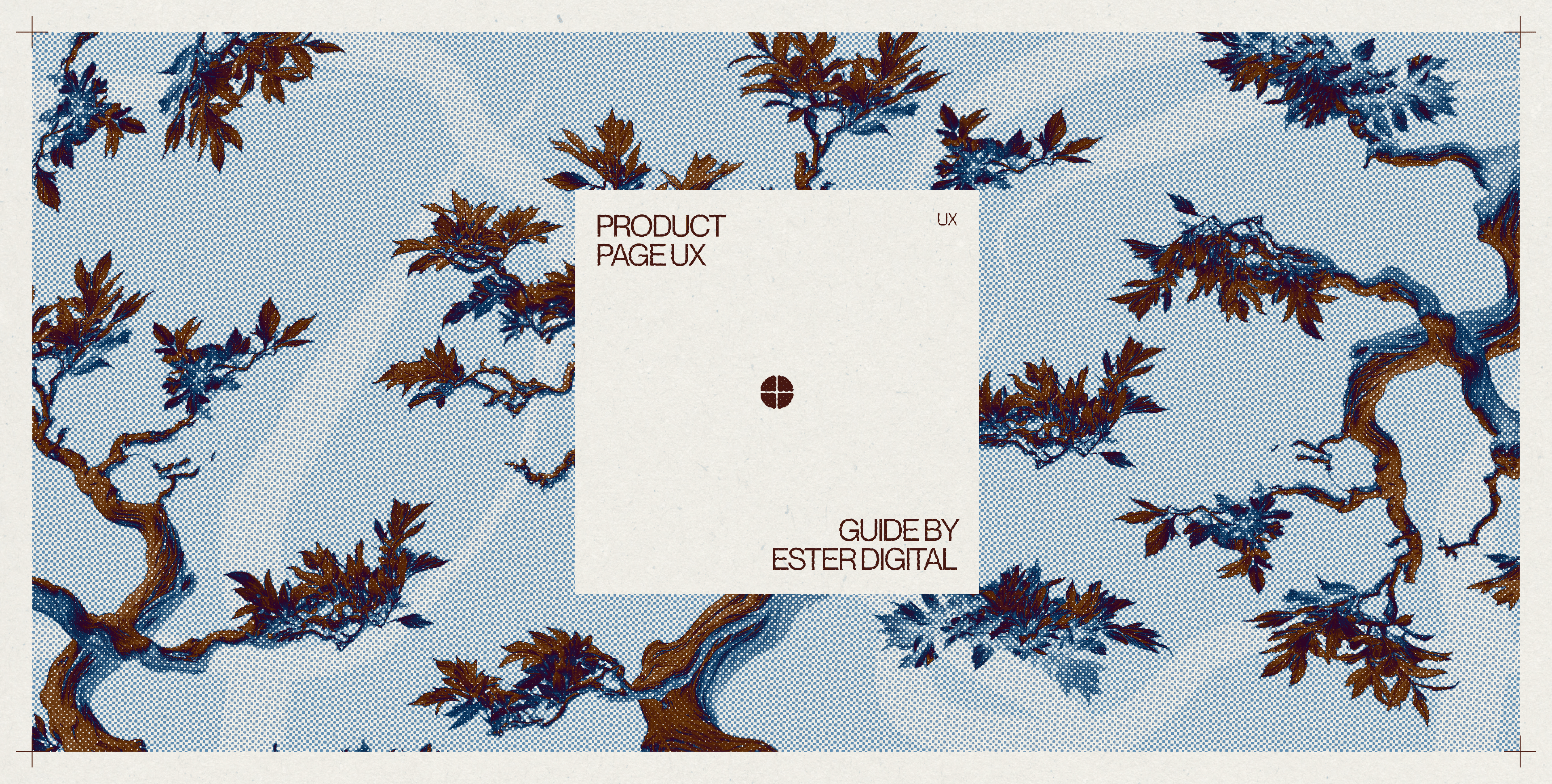Outline:
Ever landed on a product page that felt like stepping into a messy store? Where the product you thought you wanted is buried under confusing descriptions and lackluster images? Chances are, you didn’t stick around to make that purchase. You’re not alone in this—many potential buyers turn away from deals because the product page UX doesn’t live up to their expectations or the excitement of their initial interest.
Think of your product page as the ultimate salesperson: it’s there 24/7, ready to show off your products in the best light and clinch that sale. In e-commerce Web Design & Development, product pages are the battleground where you win or lose conversions. It’s the place where your customers make the decision to buy. This product page UX guide by Ester isn’t just about avoiding common pitfalls; it’s about mastering the art of product page design that shines irresistibly and convinces customers that they’re making the right choice.
Understanding Product Page UX: The Key to Customer Conversions
At its core, product page UX design focuses on crafting pages that aren’t just visually appealing but are engineered for ease of use and optimized for conversions. This involves a thoughtful layout of elements, intuitive navigation, and interactive components designed to mesh well with the user’s needs and shopping habits.
The Consumer’s Perspective: What Makes a Product Page Work
For shoppers, a stellar product page is one that seems to answer their questions before they’ve even asked them. It’s a page that feels tailor-made for their needs, whether they’re still pondering or ready to buy. They appreciate:
- Crisp, engaging images and videos that make them feel like they’re seeing the product in person.
- Rich, concise descriptions that not only list features but explain how the product makes life easier or better.
- Transparent reviews and ratings, giving insight into the experiences of others without having to leave the page.
- Upfront cost details and delivery options, ensuring there are no last-minute surprises.
- Effortless navigation paths to similar or complementary products, enhancing the shopping experience.
The Designer’s Perspective: Crafting High-Performing Product Pages
For designers, achieving an excellent UX on a product page means stepping into the shoes of both the client and their customers. It’s about anticipating needs and addressing them proactively through design choices such as:
- Responsive design solutions that ensure flawless functionality across all types of devices and screens.
- Streamlining performance to eliminate wait times; every second a page takes to load can lose a customer.
- Iterative testing of key elements, like different CTA button colors or placement, to determine what effectively drives user action.
- Prioritizing accessibility, ensuring everyone, regardless of ability, can navigate and interact with the page effortlessly.
- Leveraging psychological elements subtly, like showcasing limited availability to create urgency without pressure.
By marrying these detailed customer insights with sophisticated design techniques, UX designers can craft product pages that not only draw visitors in but convert them into loyal customers.
From Basic to Brilliance: Your Product Page Design Features
With a solid grasp of product page design under our belt, it’s time to dive into the features that can transform a basic product page into a conversion machine. They’re not just about functionality; they’re about building an experience that resonates deeply with your audience, igniting their interest and propelling them towards that coveted “buy” button.
The Features Every Product Page Needs
These features are the must-have—the bread and butter of your product page. They’re non-negotiable if you want to meet the basic expectations of your shoppers and keep your page functioning smoothly:
- Vivid Images and Dynamic Videos: Imagine trying to buy a dress without seeing how it twirls or a gadget without understanding its size in your hand. High-quality visuals are crucial. They should offer multiple angles, zoom capabilities, and perhaps a video to show the product in action, making it feel almost tangible through the screen.
- Rich Product Descriptions: Ever picked up an item in a store and turned it over in your hands, examining every detail? Your online description should allow the same level of discovery. It should tell the full story of the product, highlighting how it can make life easier, more enjoyable, or simply better.
- Transparent Pricing and Availability: No one likes to be kept guessing. Always display the price prominently and provide real-time information about the product’s availability. If it’s the last one in stock or on a special sale, make sure your customers know!
- Streamlined Navigation to Purchase: The path from arrival to purchase should be as smooth as a good conversation—natural, direct, and without unnecessary detours. Ensure that your ‘Add to Cart’ button is easy to find and that the checkout process is a breeze.
Features that Set Your Product Page Apart
While not essential, these elements can greatly enhance the shopping experience and set your product page apart from the competition:
- Interactive Product Customization Tools: Letting customers play around with color options or even parts of the product can make the shopping experience personal and fun.
- Live Chat Support: Sometimes, shoppers have questions that FAQs can’t answer. Offering live support can make a big difference in conversion rates by providing real-time assistance right when it’s needed.
The “Wow” Factor: Fancy Features for an Unforgettable User Journey
When you want to go the extra mile, these features can dazzle and delight your users, potentially turning a casual browser into a loyal customer:
- Augmented Reality Views: Imagine letting your customers see how a piece of furniture looks in their own living room or how a hat looks on their head via their smartphone camera. AR can bridge the gap between imagination and reality, providing a powerful push towards making a purchase.
- Social Sharing Options: Make it easy for customers to share their favorite finds with their network. It’s free marketing for you and fun for them.
While wondering how to design an eCommerce website with an outstanding product page, crafting a captivating product journey, not just a sales pitch is crucial for your success. By strategically selecting features and tailoring them to your audience’s desires, you’ll transform your product page into an interactive experience that fosters satisfaction and loyalty.
How to Design Product Page: UX Secrets You Need to Know
With a strong foundation of essential product page UX features, it’s vital to base your design on proven principles. Following these ecommerce ux product page best practices, you’ll craft a page that’s not just functional, but resonates with users, boosting engagement and conversions.
Clarity is King
Every element on the product page should serve a clear purpose. Avoid clutter at all costs. From the text to the images, clarity helps consumers understand your product and its benefits without confusion or distraction. Clear, concise messaging paired with strong visual elements guides the user intuitively through the buying process.
Consistency Breeds Familiarity
Maintain a consistent look and feel across all product pages. This consistency extends to navigation, typography, colors, and overall style. It builds a sense of familiarity and trust with your users, making them feel more comfortable as they browse your site and more likely to make a purchase.
Accessibility Opens Doors
Ensuring your product pages are accessible to everyone, including people with disabilities, is not just a legal necessity in many cases—it’s also a moral and commercial imperative. Simple adjustments, like text descriptions for images (alt text) and keyboard-friendly navigation, can open your product pages to a wider audience.
Mobile Optimization is Non-negotiable
With an increasing number of users shopping on their smartphones, your product pages must perform flawlessly on mobile devices. This means faster load times, touch-friendly interfaces, and designs that adjust to smaller screens without losing functionality or aesthetic appeal.
Engagement Through Interaction
Interactive elements such as zoom-in capabilities, color-changing features, and videos can transform passive viewers into engaged users. These features should enhance the shopping experience without being overbearing or detracting from the main goal: conversion.
Testing Leads to Perfection
Constantly test and refine your product pages based on user feedback and behavior. A/B testing different layouts, calls to action, and content can reveal what truly works for your audience, helping you to optimize for better results.
Tips for Product Page UX Design: How to Perfect Your Product Pages
Ready to unlock the full potential of your product page? We’ve compiled actionable tips to help you perfect your product page UX design and create an exceptional user experience. These tips go beyond basic functionality, helping you harness user attention and propel them towards conversions.
Simplify the Journey
Keep the user journey as straightforward as possible. Minimize the number of clicks from landing to checkout. Simplification isn’t just about reducing steps, but making each step clear and obvious. For example, use breadcrumbs to help users track their navigation and big, bold buttons for important actions like ‘Add to Cart’ or ‘Buy Now’.
Leverage High-Quality Visuals
Never underestimate the power of a great image or a well-crafted video. Invest in professional photography and consider different contexts in which a customer might use your product. Show your product being used in real-life scenarios to help potential buyers visualize themselves using it. Remember, a picture is worth a thousand words, and a video could very well be worth a thousand pictures.
Optimize for Speed
Speed is a silent salesman. A fast-loading page can significantly boost user satisfaction and directly impact your conversion rates. Regularly test your page speeds and compress images, leverage browser caching, and minimize JavaScript and CSS files. Every second you shave off your loading time could increase customer trust and engagement.
Write for Your Audience
Craft your product descriptions and any text on your page to speak directly to your audience’s needs and desires. Use language that resonates with them, addressing common questions and concerns. This approach helps build a relationship and trust, making visitors more likely to convert to customers.
Incorporate Social Proof
Understanding the advantages and disadvantages of ecommerce can help you tailor your product pages effectively. While ecommerce offers the advantage of reaching a broad audience with lower overhead costs, it also brings challenges like intense competition and the absence of physical interaction, which can impact customer trust.
Social proof can significantly influence buying decisions by providing reassurance that others have had positive experiences with your product or service. Make sure these elements are authentic and easy to navigate.
Test and Learn
The only way to truly know what works is to test different elements on your product pages. Use A/B testing to experiment with different layouts, images, and copy to see what resonates best with your audience. Collect data and use it to continuously refine your approach.
Stay Mobile-Friendly
With more people shopping on their mobile devices than ever before, ensuring your product pages are mobile-friendly is crucial. This means touch-friendly interfaces, readable fonts, and elements that adjust well to smaller screens. Test your pages on various devices to ensure a smooth user experience.
On a Final Note
The future of product page design will likely see advancements in technology and user expectations that will push the boundaries of current UX practices. We can anticipate more personalized and interactive experiences, perhaps through AI-driven content and augmented reality, allowing users to see products in their own space before buying.
However, the core principles remain: understand your audience, prioritize user experience, and constantly iterate. Ready to craft a product page that converts? Contact us to learn how we can help you elevate your e-commerce game.





